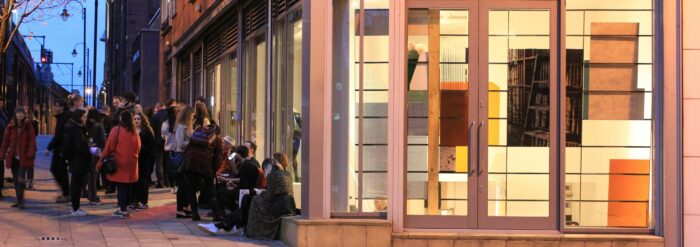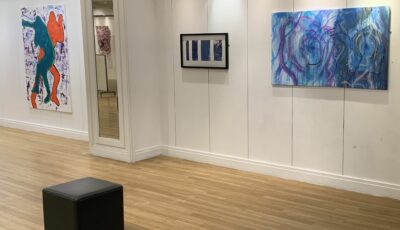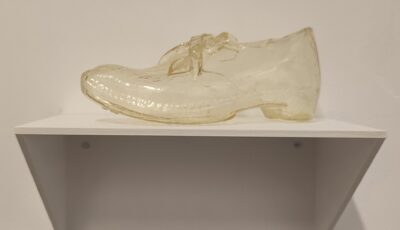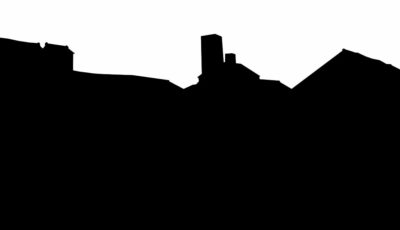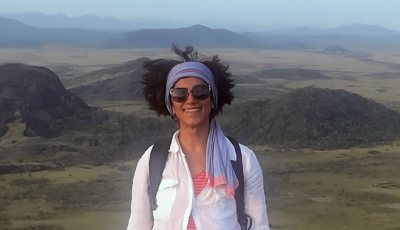Spotlight: Artists and Sustainability – Matthew Pendergast, Castlefield Gallery’s Deputy Director and Curator
Posted on 28 January 2022
As we begin 2022, and in a slight change to our regular series; Spotlight – Artists and Sustainability, where we ask artists to share their work and thoughts on how it might relate to climate change, this month we hear from Castlefield Gallery’s Deputy Director and Curator Matthew Pendergast on what it means to him and the gallery.
—
In what ways do you feel your work might relate to issues of climate change and sustainability, in the content of the work, its narrative, conceptually or theoretically. How might it speak to or challenge public discourse?
As a curator this question first of all makes me think about learning from and sharing with audiences the work of artists and great people, who with different kinds of knowledge and perspectives, put these issues at the forefront of what they do. This is something you will find in Castlefield Gallery’s programme past, present and future, but one of the reasons we started asking artists these questions was the realisation that many of the artists we are working with have something to offer this conversation about climate change and sustainability without it necessarily being the main focus of their practice.
It might be that their work encourages us to think about our relationship to the body and nature as with Jocelyn McGregor’s current exhibition Mantle (16 Jan — 20 Feb 2022). Or perhaps less immediately obvious but nevertheless relevant, would be John Powell-Jones CYBERJUNK (17 Oct — 19 Dec 2021). A universe where humanities technological hubris and desire for progress for the sake of progress has led to a dystopian nightmare. What is particular about Powell-Jones work is his emphasis on the affect dominant ideologies and power structures have on our perceptions of reality. How the warped western view of progress and success affects our understanding of morality. Leading to a situation where technological progress and the gains of a small human elite are placed above the health and wellbeing of the Earth and the rest of its inhabitants.
Last Summer we worked with Nicola Ellis on her exhibition Nicola Ellis and Ritherdon & Co Ltd: No gaps in the line (13 June – 1 August 2021), in the build up to which Ellis had spent two years in Darwen, Lancashire, as artist in placement at Ritherdon & Co Ltd, a family-run manufacturer of specialist steel enclosures. At the heart of her ongoing placement is the will to create situations where both artist and manufacturer can observe, learn and benefit from each other. In particular, Ellis developed new works and methodologies informed by studying the application of Lean Manufacturing philosophy – a philosophy aimed at the reduction of waste in the form of time, energy and materials. With the exhibition and a programme of talks, podcasts and other online resources we were able to share this project with audiences and expand its potential to enter wider public discourse.
With regards the materials, processes and techniques you use to produce your work, are there any practical decisions you make with regards climate change and sustainability
We always want to support the artists we are working with to be as ambitious as possible, but we also have to balance this against the practical considerations and constraints of gallery spaces, health and safety, accessibility and budget. Now as part of our environmental policy, sustainability is also an embedded part of these considerations.
We reuse and recycle what we can, but the specific requirements of some artworks means that exhibition making unavoidably produces things that are difficult to reuse. Some materials like MDF (sheet material for cladding temporary walls) are by their nature difficult to use more than once as they damage easily. As well as making sure that what MDF we do buy is FCS (Forest Stewardship Council) certified, we are trying to cut back on the amount of MDF we use and find alternatives to it, as it also emits potentially harmful amounts of formaldehyde when its cut. One thing we and others elsewhere have done is to design parts of exhibitions to include visibly reused or damaged material. This may not be suitable for every exhibition but perhaps increasingly the clean box of the white cube just isn’t the necessary default it once was.
In more general terms planning ahead is one of the best ways to avoid unnecessary waste. Giving yourself time to source things better, to be generally more efficient and avoid mistakes. Nothing feels more wasteful than having to remake something because of a mistake that could have been avoided with better planning.
In general, how do you feel galleries, art spaces, artworks and artists, might be able to contribute, what if any role do you feel they can play in a progressive conversation.
One of the great qualities of artworks and exhibitions is their ability to provoke and create space for different kinds of thinking and dialogue, perhaps you could also say different speeds than what we generally encounter elsewhere in our daily lives. Whether it is on Twitter or the BBC, arguments are usually quickly reduced to polemics, split across part political lines. This is coupled with the fact that vast amounts of information is shared and consumed via news agencies and social media platforms which have largely undisclosed agendas. As a result, we find ourselves in a political climate in which simple lies win out against complex truths. The more easily digestible, rememberable and repeatable the argument, the better it spreads and the more it convinces.
Arts relationship to politics is messy to say the least, but art has unique potential. The best artworks forever elude us, they remain unresolved, resistant to any final interpretation. This enables them to open up and sustain areas of nuanced, even contradictory thought and discussion. In this way art and artists can complement or challenge other realms of public discourse where progressive thinking is often oversimplified. In short we need spaces where the work of Ellis and Powell-Jones, which at first may appear contradictory (with one seemingly all for progress and the other against it) are part of the same programme. Of course if you visited either of those exhibitions you will know their work is not at as simple as that. What exhibitions and galleries provide is a space where these artists and their work can contextualise each other, bringing nuance and complexity to each other rather than contradiction born of oversimplification.
Are there any tips or advice, anything you have learnt you might want to share with other artists or our audiences
It might at first sound contrary to the above calls to keep things complex, open and nuanced, but as much as we should resist the reduction of arguments to oversimplified polemics we must also resist the temptation to overcomplicate things. A recent and perhaps for some nauseatingly mundane example, though for me it felt like a minor revelation, would be the design of a temporary timbre framed and MDF clad room and projection space in the gallery. There was some freedom with regards determining the exact size of the room so rather than choosing an arbitrary point and cutting everything to fit, where possible the dimensions of the room were determined by the dimensions of the sheet material (2440mm x 1220mm, 8 x 4ft) not only did this reduce the need to cut down boards into difficult to reuse sizes but it also reduced the amount of labour time and power tool use as well as the need to fill and sand where the joins meet.
When I read back what I have just written it sounds so obvious, but so often in the past other considerations and worthy ones at that, such as AV specifications, how people navigate the space as well as the overall look of the exhibition, have taken president without question. This leads to countless long thin cuts of MDF pilling up in the wood store after installs. A familiar sight to many gallery technicians I’m sure. Making exhibitions will always involve balancing priorities but making sustainability one of those priorities isn’t necessarily to the detriment of others. Sometimes the best way to negotiate these competing priorities is to look for simple elegant solutions, which may require the force of thought needed to overturn received wisdom and entrenched ways of doing things but it doesn’t always have to mean more work! This is indeed the spirit of ‘Lean Manufacturing Philosophy’.
So my advice over all would be to remember that sadly it does seem more than ever that we live in times where ‘simple lies win out against complex truths’ but that also, sometimes ‘the easy way is the right way’. To word it differently: the simple obfuscates the complex and the complex obfuscates the simple. Despite the abstract nature of that philosophical formula it does of course have immediate real world and practical implications. If you are looking for somewhere where these dynamics are unpacked and challenged then look no further than wherever exhibitions are being made: the time, energy, materials and problem solving that goes into them and the worlds of potential thought and experience they offer.
January 2022: Matthew Pendergast
